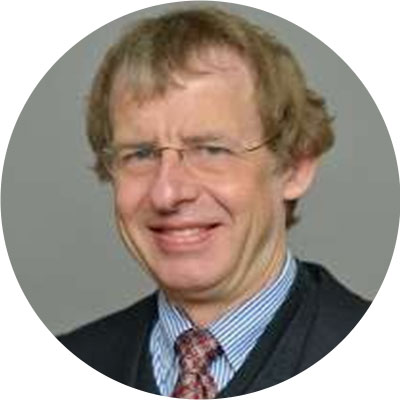- Ph.D. Thesis: Max Planck Institute for Dynamics and Self-Organisation,Göttingen (advisor: Prof. Dr. J.P. Toennies) 1987
- Diploma: Physics (advisor: Prof. Dr. J.P. Toennies) 1984
- Studies: Physics, Georg-August-University Göttingen 1979 – 1984
Academic Career
- Member of German National Academy of Sciences (Leopoldina). 2016 -
- Professor (C4), KIT, Director Institute of Functional Interfaces (IFG) 2009 –
- Full Professor (C4), Chair of Physical Chemistry I, Ruhr-Universität Bochum 1997 – 2009
- Heisenberg Fellow of the DFG, Research activities in Heidelberg 1993 – 1996
(Applied Physical Chemistry) and Göttingen, (Max Planck Institute for Dynamics and Self-Organisation) - Hochschuldozent (C2; equivalent to Assistant Professor) at the 1992 – 1993
Chair of Applied Physical Chemistry, University of Heidelberg - Research Assistant at the Chair of Applied Physical Chemistry, 1989 – 1992
University of Heidelberg, Germany (advisor: Prof. Dr. Michael Grunze) - Postdoctoral fellow, IBM-Research Division, San Jose, CA, USA, 1988 – 1989
(advisor: Prof. Dr. Shirley Chiang (now at University of California at Davis))
Position Held:
Professor (C4) in Physical Chemistry
Director Institute of Functional Interfaces at KIT
Research Areas
Fundamental processes in Surface Physics and Surface Chemistry, Metal-Organic Frameworks (MOFs), development and advancement of techniques for the characterization of molecular adsorbates and oxide surfaces, surface science (SURMOFs).
Selected publications
- MOF‐hosted enzymes for continuous flow catalysis in aqueous and organic solvents
R. Greifenstein, T. Ballweg, T. Hashem, E. Gottwald, D. Achauer, F. Kirschhöfer, M. Nusser, G. Brenner-Weiß, E. Sedghamiz, W. Wenzel, E. Mittmann, K. S. Rabe, C.M. Niemeyer, M. Franzreb, Ch. Wöll
Angew. Chemie Intl. Ed. 2022, e202117144, 1-7 - FAIR data enabling new horizons for materials research
M. Scheffler, M. Aeschlimann, M. Albrecht, T. Bereau, H.-J. Bungartz, C. Felser, M. Greiner, A. Groß, Ch. T. Koch, K. Kremer, W. E. Nagel, M. Scheidgen, Ch. Wöll, C. Draxl
Nature 2022, 604, 635-642 - Avoiding the Center‐Symmetry Trap: Programmed Assembly of Dipolar Precursors into Porous,
Crystalline Molecular Thin Films
A.Nefedov, R. Haldar, Zh. Xu, H. Kühner, D. Hofmann, D. Goll, B. Sapotta, S. Hecht, M. Krstić, C. Rockstuhl, W. Wenzel, S. Bräse, P. Tegeder, E. Zojer, Ch. Wöll
Advanced Materials 2021, 2103287 - Defect‐Engineered Metal–Organic Frameworks: A Thorough Characterization of Active Sites Using CO as a Probe Molecule
J. Wang, W, Wang, Zh. Fan, S. Chen, A. Nefedov, S. Heißler, R.A. Fischer, Ch. Wöll, Y. Wang
J. Phys.Chem. C 2020, 125, 1, 593-601 - Interplay of Electronic and Steric Effects to Yield Low‐Temperature CO Oxidation at Metal Single Sites in Defect‐Engineered HKUST‐1
W. Wang, D. I. Sharapa, A. Chandresh, A. Nefedov, S. Heißler, L. Heinke, F. Studt, Y. Wang, Ch. Wöll
Angew. Chemie Int. Ed. 2020, 59 (26), 10514-10518 - Guest‐responsive polaritons in a porous framework: chromophoric sponges in optical QED cavities
R. Haldar, Z. Fu, R. Joseph, D. Herrero, L.Martín-Gomis, B. S. Richards, I.A. Howard, Á. Sastre-Santos, Ch. Wöll
Chem. Sci. 2020, 7972, 11, 7972-7978 - Introducing electrical conductivity to metal‐organic framework thin films by templated polymerization of methyl propiolate
B. Sen, J. C. C. Santos, R. Haldar, Q. Zhang, T. Hashem, P. Qin, Y. Li, F. Kirschhöfer, G. Brenner-Weiß, H. Gliemann, L. Heinke, Ch. Barner-Kowollik, A. Knebel, Ch. Wöll
Nanoscale 2020, 12, 24419-24428 - Rendering Photoreactivity to Ceria: The Role of Defects
Ch. Yang, X. Yu, P.N. Pleßow, S. Heißler, P.G. Weidler, A. Nefedov, F. Studt, Y. Wang, Ch. Wöll Angewandte Chemie Intl.
Ed. 2017, 56 (45), 14301-14305 - Surface Faceting and Reconstruction of Ceria Nanoparticles
C. Yang, X. Yu, S. Heißler, A.Nefedov, S. Colussi, J. Llorca, A. Trovarelli, Y.Wang, Ch. Wöll, Angew. Chem., Int.
Ed. 2016, 56, 375-379
AI-Ready Multifunctional Molecular Solids via Atomically Precise Assembly of Building Blocks: The SURMOF Approach
Christof Wöll
1Institute of Functional Interfaces (IFG), Karlsruhe Institute of Technology, North Campus, 76021 Karlsruhe, FRG
Realizing molecular “Designer Solids” by programmed assembly of building units taken from libraries is a very appealing objective. Recently, metal-organic frameworks (MOFs) have attracted a huge interest in this context. Here, we will focus on MOF-based electrochemical, photoelectro-chemical, photovoltaic, and sensor devices. Internal interfaces inside MOF heterostructures are also of interest with regard to photon-upconversion and the fabrication of diodes.
Since the fabrication of reliable and reproducible electrical contacts to MOF-materials represent a major challenge, we have developed a layer-by-layer (lbl) deposition method to produce well-defined, highly oriented and monolithic MOF thin films on appropriately functionalized substrates. The resulting films are referred to as SURMOFs [1,2] and have very appealing properties in particular with regard to optical applications.[3] The fabrication of hetero-multilayers is rather straightforward with this lbl method. In this talk, we will describe the principles of SURMOF fabrication as well as the results of systematic investigations of electrical and photophysical properties exhibited by empty MOFs and after loading their pores with functional guests. We will close with discussing further applications [4] realized by loading MOFs with nanoparticles or quantum dots and by creating molecular solids lacking inversion symmetry for second harmonic generation (SHG).[5] We will also demonstrate that the SURMOF-approach is also well suited for the application of Artificial Intelligence (AI) methods, e.g. Large Language Models (LLM) and Machine Learning (ML).
References:
[1] J. Liu, Ch. Wöll, Chem. Soc. Rev. 46, 5730-5770 (2017)
[2] L. Heinke, Ch. Wöll, Adv. Mater. 31 (26), 1970184 (2019)
[3] R. Haldar, L. Heinke, Ch. Wöll, Adv. Mater. 32, 1905, (2020)
[4] A. Chandresh, X. Liu, Ch. Wöll, L. Heinke, Adv. Sci., 8, 2001884 (2021)
[5] A. Nefedov, R. Haldar, Zh. Xu, H. Kühner, D. Hofmann, D. Goll, B. Sapotta, S. Hecht, M. Krstić,
C. Rockstuhl, W. Wenzel, S. Bräse, P. Tegeder, E. Zojer, Ch. Wöll, Adv. Mater. 33, 2103287 (2021)
[6] D.Chen, H. Gliemann, Ch. Wöll, Chem. Phys. Rev. 4, 011305 (2023)




